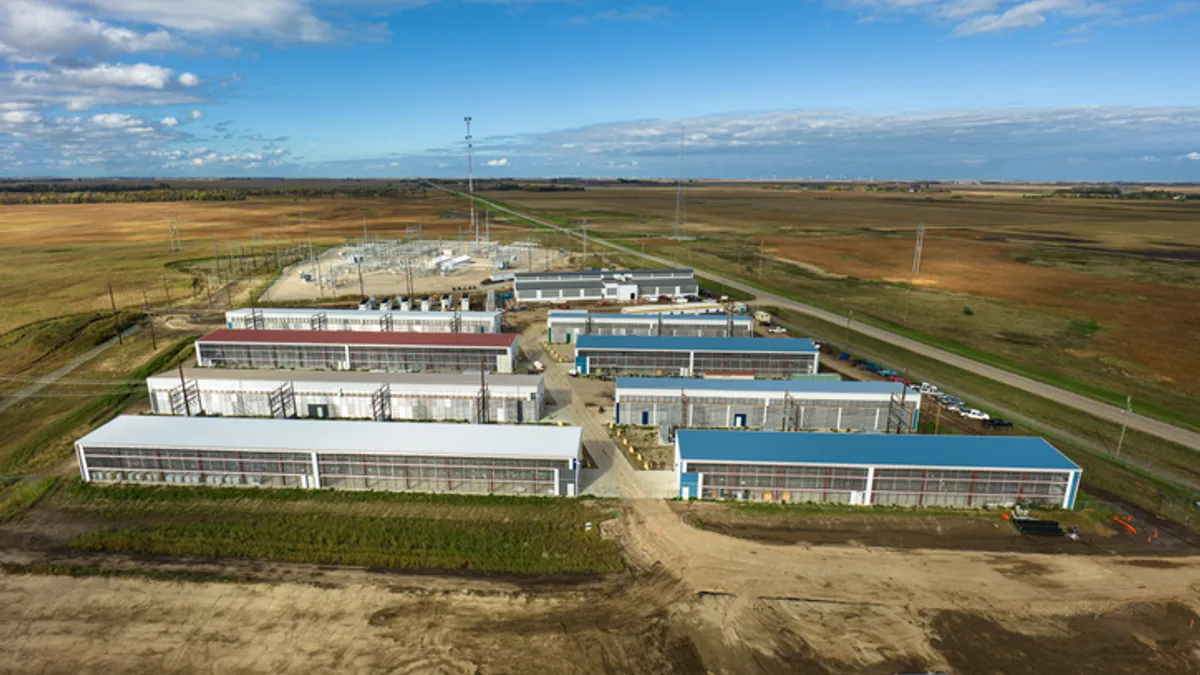It’s a statistic that could startle an entire industry: Cost effective distributed energy resources (DERs) are expected to displace 320 GW of centralized generation from 2014-2023, according to Navigant Research.
As early as 2018, the firm expects DERs could be outpace centralized generation in annual capacity additions. That trend, Navigant notes, is seen by many as “the supreme threat to incumbent distribution utilities, echoing the much-ballyhooed utility death spiral storyline.”
Those predictions have been public since late 2014, helping stoke worries that DER proliferation would combine with stagnant load growth to undermine utility finances across the nation.
Those concerns are especially significant for municipal electricity providers, whose small size and elected governing boards can make it more difficult to raise rates to cover expenses. But in a new report, the research and consulting firm notes the distributed energy trend can also help munis “reinvent” themselves with digital economy business strategies that create “two-way and mutually beneficial relationships with customers.”
Software-managed energy storage can do that and create “win-win scenarios” that deliver benefits to consumers, the utility, and the grid at large, according to the new report "Making Sense of New Public Power DER Business Models; The Business Case for Energy Storage.” These benefits can impose order on the potential “chaos” of the emerging DER-dominated bi-directional electron flow, Navigant argues, and can be applied to munis, cooperative utilities, and investor-owned power providers alike.
Nanogrids, microgrids and virtual power plants
Commissioned by battery energy storage provider Sunverge Energy, the paper describes storage applications in nanogrid, microgrid, and virtual power plant deployments that can help public power providers take advantage of the DER transition.
The Navigant definitions of nanogrid, microgrid, and virtual power plant (VPP) are somewhat imprecise, said report author Peter Asmus, but they are derived from U.S. Department of Energy definitions.
A microgrid, the best-known of the three technologies, “is a distribution network that incorporates a variety of possible DER that can be optimized and aggregated into a single system that can balance loads and generation with or without energy storage and is capable of islanding whether connected or not connected to a traditional utility power grid,” according to the report.
While microgrids typically include many DERs, it can be more difficult to distinguish nanogrids, their smaller counterparts, from a single distributed energy installation.
“A nanogrid is a small microgrid, perhaps only a building with a solar system of no more than 100 kW and a battery,” Asmus said. In the report, Navigant identifies it as a small electric domain limited to a single electric demand source or “network of off-grid loads not exceeding 5kW,” with devices “capable of islanding and/or energy self-sufficiency through some level of intelligent DER management or controls."
A virtual power plant, by contrast, is the largest version, which “relies upon software and a smart grid to remotely and automatically dispatch and optimize DER via an aggregation and optimization platform linking retail to wholesale markets.”
“The keys to the VPP concept, and it is at present mainly a concept without a real market presence, is that services are managed in real time and delivered upstream so there is value to either the utility or the grid operator,” Asmus added.
Storage blurs the boundaries
One of the purposes of the paper, Asmus said, is to use case studies to show how energy storage systems are allowing the three network concepts to “merge.”
“It is becoming difficult to say whether an installation is a nanogrid, a microgrid or a VPP,” he said. “The lines are blurring because storage is a bridging technology.”
In the last year, energy storage has begun following solar PV down the cost curve, the paper reports. The biggest impact is now on nanogrids, but it is also improving the business case for microgrids and is expected to impact VPPs.
By 2025, a 5 kW solar array is expected to be $2,250/kW in U.S. markets, according to Navigant. By 2024 an advanced lithium-ion energy storage system is expected to be $2,500/kW in global markets. Together, those price points are likely to strongly advance the use of all three network concepts.
Navigant forecasts the 2025 North American market for residential solar PV plus energy storage nanogrids to be over 1.8 GW, with 30% to 40% of those nanogrids aggregated into VPPs. The use of solar and storage together in nanogrids is expected to continue expanding, leading to “new organized markets for ancillary services and efforts by utilities and grid operators alike to manage increased DER portfolios in ways that capture value upstream.”
Real world examples already being planned for deployment include the 50 MW Advanced Microgrid Solutions (AMS) installation and the 85 MW Stem installation contracted for by Southern California Edison (SCE) to meet needs left unserved by the 2013 shuttering of the San Onofre Nuclear Generating Station (SONGS).
Both Stem and AMS also advocate using such distribution network solutions to meet potential unserved needs resulting from the huge methane leak that forced the Aliso Canyon natural gas storage facility out of use last year. Electricity shortages in the LA Basin stemming from natural gas shortages could be alleviated by networked DERs, Asmus said.
Similar to that program, the Navigant study outlines three case studies of storage projects allowing public power providers to optimize DERs — the Sacramento Municipal Utility District (SMUD) R Street Midtown pilot, PowerStream of Ontario’s POWER.HOUSE demonstration, and the just-implemneted Glasgow Electric Plant Board (EPB) Infotricity demand charge program in Kentucky.
Because the study was commissioned by Sunverge, all three projects involve the company’s battery storage hardware and software, but there are a litany of competitors in the space as well. Other providers of comparable systems, according to Asmus, include Advanced Microgrid Solutions, Younicos, Greencharge Networks, Greensmith, and Stem.
SMUD’s R Street demonstration
For its R Street Midtown Project, SMUD equipped 34 single-family homes with a 2.25 kW solar array, the Sunverge Solar Integration System energy storage product, smart plug load controllers, and smart thermostats.
“Each house is a nanogrid because it can island itself, the whole block can island as a microgrid, and, because it provides demand response to the SMUD distribution system, it can be considered a VPP,” Asmus said. “It can be all these things, at different times of the day, because battery storage is integrated into it.”
The Sunverge integration system is currently optimizing the SMUD R Street pilot and has the capability to take advantage of new rates and utility programs as they evolve, noted Lupe Jimenez, the utility’s demand response program manager.
“One could envision a future where customers can participate in a transactive grid or provide distribution-level demand response for reliability using price signals to motivate customer participation,” she said.
The technology has proven itself, at least in the pilot phase. Homes in the project have 85% lower electricity bills than comparable homes without solar or storage. The network has been able to meet 100% of its demand response targets. In some scenarios, stored energy was dispatched and net peak load for homes with storage was reduced to zero.
In addition, customers with solar and storage had bill savings 33% better than customers with only solar. And, because of the technologies’ capabilities, time-varying rates increased bill savings by over $50/month.
During a nine day period in 2015, R Street homeowners saved a collective $445 and, in May of this year, the project reduced its peak load by 93%, according to Sunverge CEO Ken Munson.
An important software advance for Sunverge and other current DER providers would be an interface that can be “easily integrated into backend utility systems,” Jimenez said. “SMUD favors technologies that take advantage of open standards and APIs to enable seamless integration into utility visibility and control systems.”
Because of the cost of energy storage, SMUD continues to see it as “an emerging technology with considerable potential” that will remain in the utility’s research and development program, Jimenez said.
“As energy storage prices continue to drop and visibility and control systems proliferate in the industry, we envision energy storage as a having significant potential for both utility and customer benefits,” she said.
PowerStream’s nanogrid houses
PowerStream a community-owned utility providing power for 380,000 customers in central Ontario. With Sunverge, the utility designed a combination nanogrid/VPP pilot project involving 20 residences. Each unit has a 5 kW solar PV array and a 6.8 kW/11.4 kWh lithium-ion battery.
Funded by Ontario’s Independent Electricity System Operator, the units were located on selected feeders to maximize system benefits while meeting customer needs.
Like R Street, POWER.HOUSE is a utility-owned demonstration. To maximize its experience with the technologies, PowerStream designed, built, owns and operates the project. In exchange an upfront payment of $3,500 and an ongoing service fee, customers are guaranteed bill savings of up to $100/month and are promised at least 50% of their energy storage capacity will always be available as backup power.
The goal, Munson reported, is to reduce customer bills by up to 80%.
The Sunverge storage system was “easily” integrated into the PowerStream distribution system, said Neetika Sathe, vice president of corporate development.
“Solar plus storage technologies have been around a long time,” she said. “The secret is to allow the utility to manage the DER system to provide benefits both to the host customer and the local grid and Sunverge 'aced' providing that value to the utility.”
Among important benefits to the customer is “arbitrage,” Sathe said. By charging the battery during off-peak periods when electricity is inexpensive and using the stored power during peak demand periods when electricity is more costly, customers are able to further reduce their bills, Sathe said.
The utility has benefited from “a degree of customer engagement that has taken us completely by surprise,” she added. “The information from the Sunverge system delivered to customers’ smart phone apps is very real and actionable and it is taking their understanding of energy use and energy efficiency to the next level.”
Both the utility and the customers see benefit in the reduction of greenhouse gas emissions (GHGs) from the use of solar and the more efficient use of grid-supplied electricity, Sathe said.
PowerStream has not yet done a full cost-benefit analysis on the pilot, but it is not likely financially feasible “with today’s economic parameters,” she acknowledged.
“The price of electricity is not high enough yet,” she said. “But there still a lot of unknowns.”
Among the potential benefits not yet quantified are the value of GHG reductions, the value of demand response and frequency regulation to the transmission system operator, and the value for meeting locational needs that defer the cost of system upgrades, Sathe said.
“We know the cost is high but what if the value is higher?”
Unlike SMUD, PowerStream has no concern with the Sunverge software and found the solar integration supplier willing to make its API available.
“It is not perfect but it was very easy to plug in and, by the time the VPP industry evolves to scale, it will be a matter of plug-and-play,” Sathe said. “We have the capability of running 20 homes in concert but the software is very scalable. We could run 200,000 homes as well.”
Glasgow’s demand charge pilot
In January, Glasgow Electric implemented its Infotricity demand charge rate or the 5,800 residential customers it serves in Kentucky, according to CEO William Ray.
The objective is to reduce the extra demand charge Glasgow pays the Tennessee Valley Authority (TVA), its power supplier, for the single hour of peak usage each month.
“The most vexing thing in the electric utility industry is the bizarre load shape we have from using simplistic, hundred-year-old rate architecture,” Ray said.
Because of those rates, system operators are forced into major capital expenditures for “an increasing amount of generation capacity that runs a decreasing amount of time, no more than two or three hours per day,” he said.
The Infotricity rate captures each customer’s coincident peak demand contribution to the monthly peak hour, which is "a big part" of the utility's wholesale power bill from TVA, according to Ray.
Glasgow homes have been retrofitted with smart wi-fi enabled Ecobee thermostats and programmable GE water heaters. Controlling software takes data from the utility’s SCADA system, incorporates forecasted weather and real time system load, and predicts the likely peak hour.
The software then “organizes load by dispatching water heating, thermostat temperature, and battery charging to mitigate each home’s coincident peak demand,” Ray said.
If the next day between 1 p.m. and 5 p.m. is the predicted highest hour of demand for the month, customers without smart technologies are warned to reduce their usage, Ray said.
The 15,000 person community has a uniquely strong broadband and cable television communications network and uses it to get the word out through social networks and media, Ray said.
Those with addressable thermostats and water heaters are notified their homes will be pre-cooled and their water pre-heated. “We are trying to treat the whole house as a battery to avoid demand charges,” he said.
Sunverge energy storage systems have been incorporated into Glasgow’s 165 homes with the highest coincident load factors. Those customers are notified that, along with significant pre-cooling and pre-heating, the Sunverge solar integration system will charge their batteries during the night so if they have additional power needs, electricity will be available.
“The objective is to get those homes to a zero contribution to peak demand,” Ray said. “We are seeing some accomplish that by manipulating the other loads in the house and deploying the batteries during the peak.”
This is, in essence, “a fleet-level VPP not unlike a large solar PV array or single utility-scale energy storage installation,” the Navigant paper observes. But “demand savings are being harvested at the point of consumption, avoiding line losses, deferring expensive distribution grid upgrades, and preserving precious land resources.”
The utility’s goal was to reduce its demand peak by 25%. A trial in September 2015 obtained a 64% peak load reduction in 46 homes equipped with storage systems, according to the paper.
“More people are saving than we projected,” Ray said. “For the first 4 months of 2016, about 2,000 residential customers paid a higher bill than they did for the same time in 2015 and about 3,800 responded to the rate and paid a lower bill.”
During the June 13 peak demand period, the Glasgow technologies reduced peak load 160 kW, 70% of total load, Munson reported from Sunverge control center data.
The utility is no longer burdened with concerns about recovering its fixed costs or selling more energy to make more money, Ray said.
“We can now help customers use less energy, improve their load factor, and save money,” he said. “If more of TVA's distributors did this, it wouldn’t need to build more generation units.”
Ray’s single concern is the cost of the Sunverge energy storage system.
“We are probably saving each customer about $400/year,” he said. “If they can bring the cost down to around $4,000, people would have a ten year payback and they would buy batteries on their own, for the savings.”
Because the cost of the storage system for Glasgow is closer to $20,000, it remains “a technology demonstration,” Ray said.
The takeaway for utilities
The emerging industry standard software platforms being pioneered by Sunverge, Stem, SolarCity, and others provide utilities with predictive analytics and cloud-based DER management which can be “the connecting hub from the edge of the grid to the generation side” as well as “compatible with most upstream standards and legacy transmission control systems,” Navigant reports.
Algorithms can predict load and generation in real time and can continuously improve predictive abilities with new customer data. Interfaces deliver system, asset, and market data selected by the utilities in real time.
This precise and intelligent DER management allows utilities to aggregate DER into VPPs and do the energy arbitrage at a system level that PowerStream’s Sathe described.
“Storage can be charged from the grid at lowest-cost times, while any power exported to other consumers through a VPP occurs primarily at times of high demand,” Navigant summarizes.
Utilities can use this energy arbitrage to their own and their customers’ benefit in a variety of ways that have one thing in common. With storage, VPPs can deliver low cost power to their networks when the cost of electricity from the grid is high.
“A lot of utilities feel like they were late to the party with solar and are trying to figure out how to respond to energy storage,” Asmus said. “Much will depend on the utility’s business model but the emerging VPP strategy is a win-win opportunity.”






















